Ijraset Journal For Research in Applied Science and Engineering Technology
- Home / Ijraset
- On This Page
- Abstract
- Introduction
- Conclusion
- References
- Copyright
SIVA - Systematic Intra Voting Authenticator
Authors: Advaith Sakhare, Akash Rathod, Sudhanwa Pande, Sunil Kumar S
DOI Link: https://doi.org/10.22214/ijraset.2023.51460
Certificate: View Certificate
Abstract
Presents a platform based on modern blockchain technology that provides maximum transparency and reliability of the system to build a trustful relationship between voters and election authorities. Without using any actual polling places, voting activity can be conducted digitally over blockchain using the infrastructure provided by the Systemic Intra-Voting Authenticator. With the help of blockchain technology, transactions are recorded in a decentralised digital ledger across a number of computers, making it impossible to change the record in the past without also changing all following blocks and getting network consent. It can be incorporated into voting processes to ensure an impartial election and lessen injustice. The Systemic Intra-Voting Authenticator uses adaptable consensus algorithms to support a scalable blockchain. Consensus algorithms are employed to make sure that each distributed system node is in agreement with the same system state. The voting transaction is made more secure and safe thanks to the Blockchain Security Algorithm used in the system. In order to execute a transaction in the chain, smart contracts offer a safe channel between users and networks. Smart contracts are automated contracts in which the contents of the agreement between buyers and sellers are entered directly into the contract. Security of the systematic intra-voting authenticator has also been brought up for consideration. The details of how to prevent a 51 percent attack on the blockchain and encrypt transactions using a cryptographic hash have also been covered. A blockchain network is said to be under assault if a group or organisation acquires control of more than half of its computer power. This is known as a 51 percent attack.
Introduction
I. INTRODUCTION
Blockchain technology will form the foundation of the suggested voting method.
Blockchain is a distributed digital ledger that keeps track of transactions on numerous computers in an open and safe manner. It is a distributed database that disperses data across a network of computers, making it challenging for one person or entity to modify the data. The suggested method will address the problem of low voter turnout by enabling people to cast their ballots for their preferred candidates using an internet-connected computer. The system will implement many voting procedures, including first-past- the-post, instant runoff voting, and single transferable vote. In order to guarantee the validity of the voting process, the suggested system will include stringent security measures. These security measures will start when a voter logs into the voting system, continue as they cast their ballot for their preferred candidate, and end when they leave the system. The technology will contain secure restrictions that will forbid a voter from casting multiple ballots for the same candidate. The suggested system needs to address concerns regarding the security of an online vote. To create a secure method of voting online, a number of issues like user authentication and validation, access permissions, information encryption, and vote security need to be thoroughly examined.
II. LITERATURE SURVEY
It is highly challenging for the government to win the trust of the electorate because the majority of voting processes are not transparent enough. The inability of old and modern digital voting systems to prevent manipulation is the cause of their failure. The main goal is to fix issues with both the conventional and electronic voting systems, including any form of mistake or unfairness that may occur when voting. Blockchain technology can be incorporated into the electoral process to ensure fair elections and lessen unfairness. Both the physical and digital voting systems have too many problems for them to be used on a large basis. This shows why a solution is necessary to safeguard the people's democratic rights. The following literature survey papers discuss blockchain-based electronic voting systems:
- "E-Voting System Based on Blockchain Technology: A Survey"
- "Blockchain-Based E-Voting System"
- "Blockchain-based electronic voting recording system design."
- "E-Voting Systems Using Blockchain: An Exploratory Literature Survey"
- "Survey on Voting Systems Using Blockchain Technology"
III. POSITIONING
A. Problem Statement
Through the use of blockchain technology applications, Systemic Intra-Voting Authenticator makes it possible to vote online. Secure, safe, and transparent transactions are made possible via blockchain technology, a decentralised system. Voters in a blockchain-based voting system can do so securely, anonymously, and with the knowledge that their ballots will be tabulated fairly and publicly.
By using blockchain technology applications, SIVA is a technique that makes it possible to vote online. With the use of write-once and encryption, this peer-to- peer blockchain voting system appends numerous electronic ledgers, allowing for the secure transmission of voter registration data and ballots over the internet. The suggested method attempts to offer a voting process that is both visible and safe for use in local elections. The method will ensure that votes are counted fairly and transparently while allowing voters to cast ballots in confidence and anonymity.
The suggested method will employ blockchain technology to safely and openly store all voting information. Smart contracts will also be used by the system to automate voting and guarantee that all votes are accurately counted.
B. Product Position Statement
For voters who want a secure and transparent voting system, Systemic Intra- Voting Authenticator is the blockchain-based voting system that ensures secure and transparent voting. Unlike traditional voting systems, our product uses blockchain technology to ensure that votes are secure and tamper-proof.
University election organisers and small-scale election organisers, Systemic Intra- Voting Authenticator is the blockchain-based voting system that ensures secure and transparent voting. Unlike traditional voting systems, our product uses blockchain technology to ensure that votes are secure and tamper-proof. SIVA can be more efficient than traditional voting systems because they eliminate the need for intermediaries and reduce the risk of errors. This means that votes can be counted more quickly and accurately, which can help increase voter confidence in the election process.
IV. PROJECT OVERVIEW
A. Objectives
Our objective is to provide a unique web-based voting system which is done using Blockchain for online voting system. Online Election System would have Candidate registration, document verification, auto-generated User ID and pass for candidate and Voters. Admin Login which will be handled by Election Commission. Candidate
Login which will be handled By Candidate, Voters will get Unique ID and Password, using which they can vote for a Candidate only once per Election.
The project is beneficial for Election Commission, Voters as the can get to know the candidate background and choose wisely, and even for Candidate.
The software system allows the Candidate to login in to their profiles and upload all their details including their previous milestone onto the system.
The admin can check each Candidate details and verify the documents, only after verifying Candidate’s ID and Password will be generated and can remove faulty accounts. The software system allows Voters to view a list of Candidates in their area. The admin has overall rights over the system and can moderate and delete any details not pertaining to Election Rules.
B. Goals
The goal is to make voting system for private institutions to be made online, so that the voters can vote remotely whenever there is a selection for the higher position in the organization.
V. PROJECT SCOPE
A. Existing System
The current electoral system is operated manually. Time is wasted since voters must travel to polling places to cast their ballots for candidates. This prevents many individuals from voting, which is one of the most significant and worrying factors. In a democracy, each and every vote is significant. A new online system that limits vote frauds and increases voting efficiency and transparency can take the place of the current traditional system.
B. Proposed System
The current voting system requires some improvement in it because of the issues mentioned above. This can be done by switching out the current system for the new one, which will reduce voting fraud and improve the efficiency of both voting and counting.
- User registration, user login, and admin login are all features of the online election system.
- The voter's information will be managed by this online voting system, which the voter can use to login and exercise his voting rights
- Voters will be required to provide their full name, age, Aadhaar card number, mobile number, and email address at the time of registration.
- Voters would be required to enter their Aadhaar numbers when requesting to vote. Once the voter has been verified, he or she can cast their ballotfor any candidate on the list. A candidate may only receive one vote from a voter per election.
- The software system enables users to log in to their profiles and upload all of their information, including any prior milestone, to the system. Each candidate's details can be checked by the admin.
- Voters can also access a list of Candidates in their neighbourhood thanks to the software system. The administrator has complete control over the system and has the authority to moderate and delete any information not related to election rules.
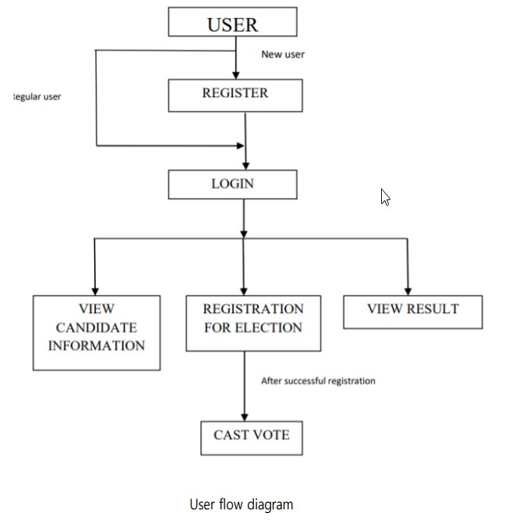
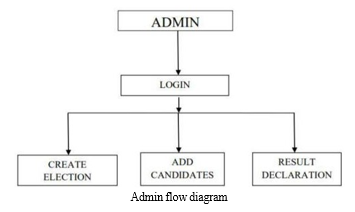
VI. METHODOLOGY
We are considering two modules that are to be completed in three phases. Two modules are as follows:
- Front-end for the application
- Back-end using Solidity to implement Blockchain.
Each of these modules will be considered as one phase and the remaining one phase will cover the connection and testing of these modules.
a. Phase 1: In this phase we will cover the front-end module, in which we will build the interactive user-interface for the admin as well as the user. In parallel the research work related to the implementation of Blockchain in decentralized application will be done.
b. Phase 2: In this phase we will cover the back-end module, we will implement the Blockchain using Ethereum framework and convert the system into a decentralized application.
c. Phase 3: The connection of two different module along with the testing of the platform will be completed in this phase.
VII. MODULES IDENTIFIED:
We have considered 2 main modules which are as follows:
A. Admin
The admin module is divided into 5 components:
- Dashboard-It will contain various charts to display information such as number of parties, number of voters etc.
- Add Candidate - In this feature of admin, he can add candidates who are standing in the election. After candidate is added it will be displayed on the user side.
- Create Election- This feature of admin will allow him to create election. A user can cast his vote only after the election is created by admin. A user can cast vote between the start date and end date.
- Election Details- In this section admin can update election details such as start date, end date etc.
- Candidate Details- In candidate details all the candidates added by admin will be displayed. Admin can update the candidate details if incase a wrong entry is done.
B. User
The user module is divided into 4 components:
- Dashboard- The user dashboard contains information about parties and their candidates. A user can see all the information about candidate.
- Voter Register- In this section first user will have to register himself only then he will be able to cast his vote.
- Voting Area- After user is registered, then only he will be directed to this page and then he can cast his vote.
- Results- In this component the user will be able to see the results of the election.
VIII. PROJECT IMPLEMENTATION
The step of the creation of the online voting system that is most crucial is the implementation of the system. The technologies and resources needed to set up and develop the online voting system will be the focus of the implementation phase. The implementation phase would be broken down into pieces, beginning with the system's point of entry and ending with the varied procedures carried out across the system.
A. Architectural Design
Many client and server side technologies would be integrated into the system's design.
- Front End
Front-End User Interface: The front-end user interface is the graphical user interface that will be used by voters to cast their votes. The user interface should be designed to be intuitive, user-friendly, and accessible to all voters.
2. Back End
The server side of the programme, which is represented by the back end of the system, is where HTTP requests submitted from the client are processed. The dynamic material will then be delivered back to the client in HTML format so that the client may read the information on the web page. A Tomcat server engine will be used to load the servlet and jsps, which can then send requests from the tomcat server engine. A database will be used to store the data that the system's clients send to it; the MySQL database will be used to store the data. A middleware layer must be developed in the form of the JDBC API driver in order for the database to be able to retrieve data from the server. This driver will be used to transform calls to Python methods into database API calls.
3. Voter Authentication and Registration Module
This module will verify the identity of voters and register them before allowing them to vote. It will use various verification techniques to ensure the authenticity of voters.
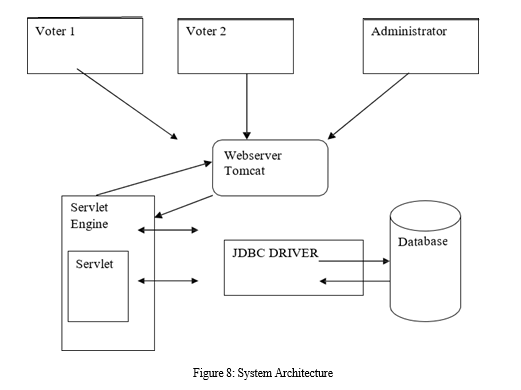
4. Class Diagram
Class Diagram describes the structure of a E-Voting System classes, their attributes, operations, and the relationship among objects. The main class of the Voting System are Admin, Cast Vote, Candidate, Voter, Admin, Polling, Result.
5. Entity Relationship Model
The database to be constructed will make use of entities and attributes as a form of structure for the database. The entities take the form of each table to be created in the database. The tables house different fields which take the form of attributes.
These attributes can be set to store certain types of data, be it text or integer values. Each entity will have an trait which will hold a primary key, a primary key is a value that can be used to identify a unique row in a table or reality. Entity relationship model were created to show the logical structure of the database and the connections between realities. The reality table gives a description of the realities used in the database. The entities used in the database system have been described in the table.
6. Entity Table
|
Entity Name |
Description |
|
Administrator |
All of the information about the administrators using the system will be kept in the administrator table. A special login will be assigned to each administrator. the characteristics that this object uses. |
|
Candidates |
All of the information on the candidates for the elections will be kept in the candidates table. Each applicant will have their own username. the characteristics that this object uses. |
|
Users |
The voters' and administrators' encrypted passwords will be kept in the user tables. Additionally, the table's "type" field will be utilised to distinguish between voters and administrators. The number of login attempts made by each user will be recorded in the Attempts column. the characteristics that this object uses. |
|
Voters |
The system will save each voter's information in the voters table. The voters table will also have fields with the records of each candidate the voter has voted for due to the high security precautions that must be taken when constructing the system; this design is necessary to avoid the possibility of a voter voting more than once. By using this method, the database table can demonstrate that each voter only cast one ballot in the event that there is any reason to suspect that the elections organiser rigged the results. Additionally, each voter's vote will be recorded in a field named "voted," which will be incremented by 1 once each vote is made. Additionally, a timestamp feature will be included to track the precise moment that each voter cast their ballot. the characteristics that this object uses. |
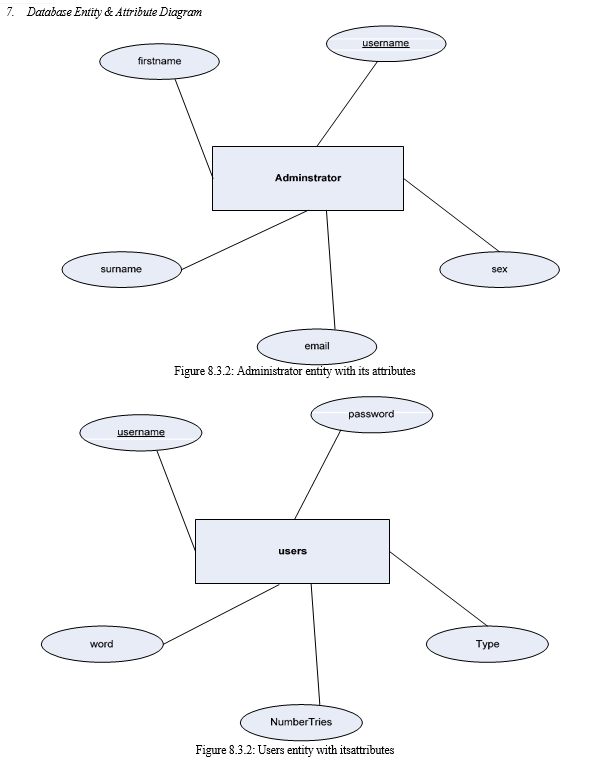
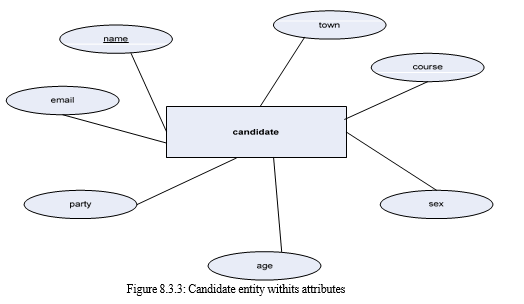
B. Sequence Diagram
In order to portray the system’s design to an end user like a system critic, it would be essential to avoid the use of complex specialized language but rather borrow a further end- user friendly design approach. The use case modeling technique can be used to visualize the conditions of the online voting system, depicting the scripts that show how the system would communicate with its voters. The system to be designed will correspond of actors who would be uniting with the system’s factors, the main actors in the system are the directors whose places within the system and the choosers whose places within the system.
- Administrator Use Case Diagram
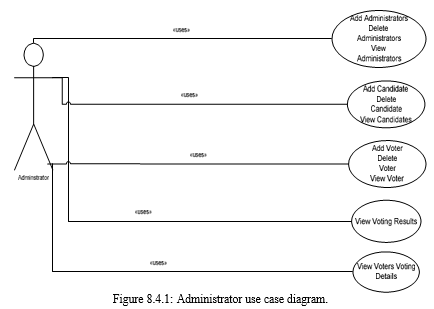
2. Voter Case Use Diagram

C. Description of Technology Used
- Blockchain Technology: The core technology used in an online voting system is the blockchain. A blockchain is a distributed ledger that records transactions in a secure and tamper-proof manner. By using a blockchain, an online voting system can ensure the integrity of the election results and prevent any attempts to manipulate or alter the votes.
- Smart Contracts: In an online voting system, smart contracts are used to enforce the rules of the election and automate the process of vote counting and result declaration.
- Cryptography: Cryptography is used extensively in an online voting system to ensure the confidentiality and integrity of the votes. Techniques such as digital signatures, encryption, and hashing are used to secure the digital tokens, verify the identity of the voters, and ensure that each voter can cast only one vote.
- Mobile and Web Technologies: Mobile and web technologies are used to develop the front-end user interface for the online voting system. The user interface should be designed to be intuitive, user-friendly, and accessible to all voters.
- Block Cipher: Block Cipher In cryptography, a block cipher is a deterministic algorithm operating on fixed- length groups of bits, called blocks. Block ciphers are specified abecedarian factors in the design of numerous cryptographic protocols and are extensively used to cipher large quantities of data, including in data exchange protocols.
IX. FINDINGS / RESULTS OF ANALYSIS
Blockchain technology has been used in online voting systems to improve transparency and security. By adopting blockchain in the distribution of databases on e-voting systems, we can reduce one of the cheating sources of database manipulation. The use of blockchain in e-voting systems can make the system more anonymous, reliable and secure while preventing any kind of frauding.
Blockchain technology can be used to create a secure and transparent voting system that offers the fairness and privacy of current voting schemes while providing the transparency and flexibility offered by electronic systems. The use of blockchain in e- voting systems can make the system more anonymous, reliable and secure while preventing any kind of frauding.
The use of blockchain technology in e-voting systems can reduce one of the cheating sources of database manipulation. By recording voting results using blockchain algorithms from every place of election, we can make the system more anonymous, reliable and secure while preventing any kind of frauding.
The use of blockchain technology in e-voting systems can also help to reduce costs associated with traditional voting methods. Blockchain-based e-voting systems are more cost-effective than traditional voting methods because they eliminate the need for paper ballots, polling stations, and other expenses associated with traditional voting methods.
In conclusion, blockchain technology has been used in online voting systems to improve transparency and security. By adopting blockchain in the distribution of databases on e- voting systems, we can reduce one of the cheating sources of database manipulation. The use of blockchain in e-voting systems can make the system more anonymous, reliable and secure while preventing any kind of frauding. Blockchain-based e-voting systems are more cost-effective than traditional voting methods because they eliminate the need for paper ballots, polling stations, and other expenses associated with traditional voting methods.
X. COST OF THE PROJECT
A. Hardware Requirements
The most common requirement defined by an operating system or software application is physical computing resources, also known as hardware. Here are the hardware requirements for this project:
- Minimum 4 Gigabyte (GB) RAM (used for processing)
- 1024 MB Memory space (approximate value)
B. Programming Languages
Programming language is a system of notation for writing computer programs. Most programming languages are text-based formal languages, but they may also be graphical. They are a kind of computer language. Here are the programming languages we will make use for this project:
a. MetaMask
b. Solidity
C. Cost Analysis
All the tools and software required in this project are open-source and are free of cost.
XI. PROJECT LIMITATIONS AND FUTURE ENHANCEMENTS:
- Limitations: Blockchain-based online voting systems have several limitations that need to be addressed before they can be widely adopted. One of the main challenges is election integrity, which is particularly important for government offices1. Another challenge is privacy protection, as blockchain-based voting systems must ensure that voters’ personal information is kept confidential. Transaction speed is another challenge that needs to be addressed for a sustainable blockchain-based electronic voting system
- Enhancements: Blockchain-based online voting systems have several limitations that need to be addressed before they can be widely adopted. One of the main challenges is election integrity, which is particularly important for government offices. Another challenge is privacy protection, as blockchain-based voting systems must ensure that voters’ personal information is kept confidential. Transaction speed is another challenge that needs to be addressed for a sustainable blockchain-based electronic voting system.
Future enhancements of blockchain-based voting systems include addressing scalability issues and improving transaction speed. In addition to these enhancements, blockchain-based voting systems can also be used to improve the security and transparency of elections. For example, blockchain technology can provide a decentralized and immutable ledger system that can be used to ensure the integrity of elections.
Conclusion
In this paper we analysed and discussed about voting system and the advantages of implementing blockchain based E-voting system that uses various blockchain based tools and using case study of manual voting process. Our goal is to offer a special E- Voting platform that serves as a platform for voter to vote from wherever he want. Using Blockchain technology it offers a new possibility to overcome the limitations and adoption barriers of electronic voting system which enables the election security and integrity and lays the ground for transparency. Using an Ethereum private blockchain, it is possible to send hundreds of transactions per second onto the blockchain, utilizing every aspect of the smart contract to ease the load on the blockchain. To achieve this, we have divided this overall work into three modules. 1) The front-end module 2) The back-end module 3) Connection of two different modules along with the testing.
References
[1] Umut Can Çabuk1, Eylül Ad?güzel2, Enis Karaarslan2; A Survey on Feasibility and Suitability of Blockchain Techniques for the E-Voting Systems; International Journal of Advanced Research in Computer and Communication Engineering, 2018. [2] Aayushi Gupta1, Jyotirmay Patel2, Mansi Gupta1, Harshit Gupta1 (2017); Issues and Effectiveness of Blockchain Technology on Digital Voting; International Journal of Engineering and Manufacturing Science. ISSN 2249- 3115 Vol. 7, No. 1 (2017). [3] T. M. Roopak and R. Sumathi, \"Electronic Voting based on Virtual ID of Aadhar using Blockchain Technology,\" 2020 2nd International Conference on Innovative Mechanisms for Industry Applications (ICIMIA), Bangalore, India, 2020, pp. 71-75. [4] Nakamoto, Satoshi (2008-10-31). \" Bitcoin P2P e-cash paper \". The Cryptography Mailing List (Mailing list). Gmane. Archived from the original on 2016-12-13. School of CSE, REVA University 2021-22 Progress Report page no. 9/ [5] Prof. Mrunal Pathak, Amol Suradkar, Ajinkya Kadam, Akansha Ghodeswar, Prashant Parde; “Blockchain Based E-Voting System”; International Journal of Scientific Research in Science and Technology; Pune, Maharashtra, India 2021;
Copyright
Copyright © 2023 Advaith Sakhare, Akash Rathod, Sudhanwa Pande, Sunil Kumar S. This is an open access article distributed under the Creative Commons Attribution License, which permits unrestricted use, distribution, and reproduction in any medium, provided the original work is properly cited.

Download Paper
Paper Id : IJRASET51460
Publish Date : 2023-05-02
ISSN : 2321-9653
Publisher Name : IJRASET
DOI Link : Click Here
 Submit Paper Online
Submit Paper Online

